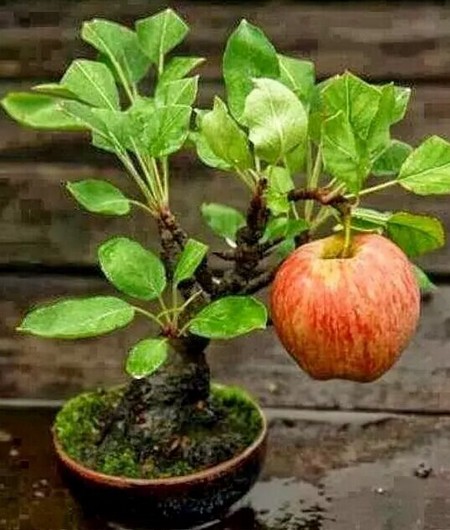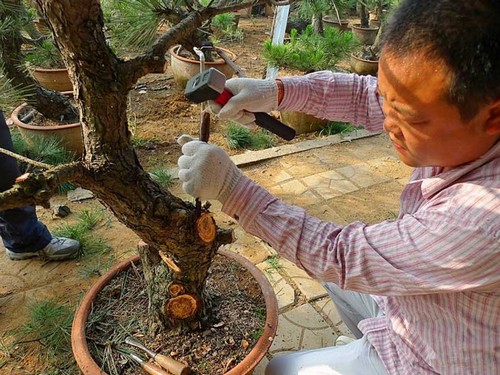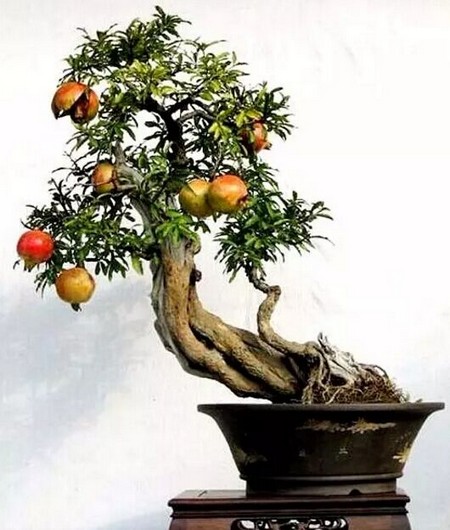Five characteristics of bonsai of fruit trees
Bonsai of fruit trees is the product of the combination of modern fruit tree cultivation techniques and traditional bonsai art, which integrates flower appreciation, fruit viewing and scenery viewing, so that the beauty of form and richness can be displayed at the same time. Beautiful flowers in spring, gorgeous like brocade, vibrant in summer, crisp fruit from small to large, changing with each passing day, golden autumn fruit colorful. The excellent works of fruit tree bonsai not only have the harvest beauty of fruit tree cultivation, but also have the artistic beauty of Chinese traditional bonsai, which has its own distinct style and characteristics.

Five characteristics of fruit tree bonsai:
1. It has both shape and fruit, and is gorgeous.
Bonsai of fruit trees is equal to shape and fruit, that is to say, it must not only have plastic arts such as root, pile, shape and spirit, but also have a sufficient number of fruits, both of which are indispensable. In the bonsai of fruit trees, fruit is an important part of the type, and the number, layout, size and color of fruits constitute an important part of the bonsai art of fruit trees. In particular, the large fruit bonsai developed in recent years, such as apples, pears, peaches, persimmons, Hawthorns and oranges in local fruit trees, carry fruit by type, shape with fruit, and have a lot of fun.
2. Full of interest in life
The roots, stems, branches, leaves, flowers, fruits and types of bonsai of fruit trees constitute an ornamental whole. Especially the bonsai of northern fruit trees developed in recent years, its spring flowers are exquisite and graceful; autumn fruits are numerous and colorful; winter is sparse branches and bones, showing vigor; and summer coincides with the period of fruit development and luxuriant leaves, and the green branches and green fruits change their new appearance in ten days, which is full of interest in life and natural flavor.
3. Rich in resources and convenient for production
China is rich in fruit tree resources. The rootstocks, seedlings and abandoned trees in fruit tree production can be used, and all kinds of wild fruit trees and their rootstock resources in the mountains are rarely developed and utilized, especially to make up for the lack of bonsai resources in the north of our country. develop local bonsai with local characteristics according to local conditions. There are many kinds and varieties of fruit trees, and the fruit shape, size, color and maturity of different tree species and varieties are different, which is suitable for a variety of shapes. Due to the use of local materials, each tree species are adapted to the local ecological conditions, without special maintenance facilities, and management examples, convenient for production, without much investment to enter the business.
4. Rough and natural styling style
Different from the general foliage bonsai, the cultivation of fruit tree bonsai should not only study the modeling, but also pay attention to the cultivation of flowers and fruits. On the other hand, the culture of flowers and fruits needs branches with certain growth potential and certain leaf area, that is, certain nutritional conditions. In addition, the flowers and fruits of some fruit trees are just at the top of the branches. All this determines that the bonsai of fruit trees can not prune and cut the branches and leaves as much as they like. The law of bonsai of fruit trees determines the rough and natural style in modeling and pruning. In terms of specifications, it can be miniaturized, but it is difficult to be miniaturized; in the treatment of branches and leaves, it can be layered, but it is difficult to become "slices"; in the overall shape, its basic shape can be as it pleases, but the details are difficult to fine-tie; the number of fruit of bonsai fruit trees changes every year, and the position of the fruit changes every year, and it is necessary to re-cultivate flowers and fruits every year, not once and for all. Cultivating bonsai of fruit trees requires certain skills, which is where its charm lies.
5. the technology is unique.
The bonsai technology of fruit trees is not only different from the general foliage bonsai, but also different from the general fruit tree cultivation techniques. In principle, it is the integration of the two, in terms of technology, it is the development of the two. Different tree species have their own growth and development rules. In the bonsai technology of fruit trees, the utilization of wild stumps and abandoned trees in production, transplanting old fruit trees (stakes) into pots to improve cultivation techniques, overwintering techniques and comprehensive measures such as nutrition management to promote and control growth and development, early forming results through grafting, pruning and other measures, expanding the cultivation area through the control of environmental factors, and so on, have greatly enriched the content of fruit tree cultivation and traditional bonsai art.
Time: 2019-05-25 Click:
- Prev

How to transplant black pine bonsai
Baizhang pine trees in the forest, aged pale scales wrinkled, this is the Song Dynasty writer Su Dongpo praise pine posture poem. Black pine bonsai has strong adaptability to the environment, and can be cultivated in courtyards and balconies. Its branches horizontal exhibition, crown such as umbrella, needle leaves thick green, winter buds silver white, evergreen, quaint tree posture, year-round appreciation. during growth
- Next

Characteristics of Root System of Fruit Tree Bonsai
Potted fruits and vegetables have long flowering period and beautiful shape, which can not only play the role of greening, but also add more interest than greening. When placed indoors, you can enjoy the whole process of fruit and vegetable flowering and fruiting in a long time. Potted fruits and vegetables have both summer varieties planted in the open air and winter varieties planted in greenhouses and greenhouses
Related
- Fuxing push coffee new agricultural production and marketing class: lack of small-scale processing plants
- Jujube rice field leisure farm deep ploughing Yilan for five years to create a space for organic food and play
- Nongyu Farm-A trial of organic papaya for brave women with advanced technology
- Four points for attention in the prevention and control of diseases and insect pests of edible fungi
- How to add nutrient solution to Edible Fungi
- Is there any good way to control edible fungus mites?
- Open Inoculation Technology of Edible Fungi
- Is there any clever way to use fertilizer for edible fungus in winter?
- What agents are used to kill the pathogens of edible fungi in the mushroom shed?
- Rapid drying of Edible Fungi

